Formula Derivation and Analysis of the Seismic Lateral Pressure of Squat Silos
Abstract
:1. Introduction
2. Derivation of the Calculation Formula
2.1. Calculation Model
2.2. Formula Derivation
3. Example Analysis
3.1. Flat Stack Working Condition
3.2. Conical Stack Working Condition
4. Numerical Simulation
4.1. The Numerical Simulation of Silo Side Pressure
4.1.1. Flat Stack Working Condition
4.1.2. Conical Stack Working Condition
4.2. Parameter Analysis
4.2.1. Effect of Material Cohesion on Silo Lateral Pressure during an Earthquake
4.2.2. Effect of Silo Radius on Silo Lateral Pressure during an Earthquake
4.2.3. Effect of the External Friction Angle on the Silo Lateral Pressure during an Earthquake
5. Discussion
6. Conclusions
- (1)
- Silo material cohesion has little impact on the squat silo seismic side pressure and can be ignored; The silo lateral pressure varies by about 10% in the bottom of the squat silo whether considering the friction or not, but its effects can be controlled within a 2% variation by simply selecting the friction angle within a reasonable range according to the silo code.
- (2)
- When in the flat stack condition, the large-diameter squat silo can be simplified as a linear retaining wall as the impact of the radius variation on the seismic lateral pressure is less than 1%; When in the conical stack condition, the silo lateral pressure increases by about 5% with the radius increase and can be calculated using the proposed new formula. In general, the proposed new formula fitted well with the numerical simulation in the flat stack case and also had a degree of superiority in the conical stack case.
- (2)
- The formula derivation was based on Coulomb theory and assumed that the silo material was in full load, as well as simplifying the horizontal seismic force as the horizontal body force, transverse force perpendicular to the silo center line, which means the study can only be applied to the direct calculation of seismic lateral pressure in squat silos when subjected to low seismic forces, and also indicates a study direction for the future.
Author Contributions
Funding
Institutional Review Board Statement
Informed Consent Statement
Data Availability Statement
Acknowledgments
Conflicts of Interest
Nomenclature
| β | Inclination angle of the silo material |
| θ | Rupture angle |
| η | Seismic angle |
| C | Cohesion in surface ABCD |
| Cw | Cohesion in rupture surface CDJK |
| N | Normal force |
| FR | Reaction force on the rupture surface |
| Fh | Volume force in the horizontal direction |
| Fv | Volume force in the vertical direction |
| R | Radius of the squat silo |
| W | Gravity of the sliding wedge |
| φ | Internal friction angle |
| φw | External friction angle |
| kh | Seismic acceleration coefficient in the horizontal direction |
| kv | Seismic acceleration coefficient in the vertical direction |
| V | Volume of the sliding wedge |
| h | Height of the squat silo |
| ρ | Density |
| μ | Poisson’s ratio |
| γ | Bulk density of the silo material |
| c | Cohesion of the silo material |
| Ka | Lateral pressure coefficient of the squat silo |
References
- Reimbert, M.; Reimbert, A. Silos theory and practice. J. Thought 1976, 5, 141–156. [Google Scholar]
- Janssen, H.A. Versuche über Getreidedruck in Silozellen. Zeitschr. Ver. Dtsch. Ing. 1895, 39, 1045–1049. [Google Scholar]
- Airy, W. The Pressure of Grain. (Including Appendixes). Minutes Proc. 1897, 131, 347–358. [Google Scholar] [CrossRef] [Green Version]
- Younan, A.H.; Veletsos, A.S. Dynamics of solid-containing tanks. I: Rigid tanks. J. Struct. Eng. 1998, 12, 52–61. [Google Scholar] [CrossRef]
- Veletsos, A.S.; Younan, A.H. Dynamics of solid-containing tanks. II: Flexible tanks. J. Struct. Eng. 1998, 124, 62–70. [Google Scholar] [CrossRef]
- Zhao, S.; Liao, H. Soil Mechanics, 2nd ed.; Higher Education Press: Beijing, China, 2010. [Google Scholar]
- Mylonakis, G.; Kloukinas, P.; Papantonopoulos, C. An alternative to the Mononobe–Okabe equations for seismic earth pressures. Soil Dyn. Earthq. Eng. 2007, 27, 957–969. [Google Scholar] [CrossRef]
- Silvestri, S.; Gasparini, G.; Trombetti, T.; Foti, D. On the evaluation of the horizontal forces produced by grain-like material inside silos during earthquakes. Bull. Earthq. Eng. 2012, 10, 1535–1560. [Google Scholar] [CrossRef]
- Yu, X.; Raeesi, A.; Ghaednia, H.; Heydariha, J.; Das, S.; Xie, S. Behavior of a large steel field silo structure subject to grain loading. J. Perform. Constr. Facil. 2017, 31, 04017038. [Google Scholar] [CrossRef]
- Tang, J.; Lu, H.; Guo, X.; Liu, H. Static wall pressure distribution characteristics in horizontal silos. Powder Technol. 2021, 393, 342–348. [Google Scholar] [CrossRef]
- Jing, H.; Wang, X.; Yang, J.; Chen, H. Static and seismic pressure of cylindrical steel silo model with granular materials. J. Constr. Steel Res. 2022, 198, 107515. [Google Scholar] [CrossRef]
- Xu, Z.; Liang, P. Modified lateral pressure formula of shallow and circular silo considering the elasticities of silo wall and storage materials. Sci. Rep. 2022, 12, 7069. [Google Scholar] [CrossRef] [PubMed]
- Shi, W.; Zhu, B. The experimental study of earthquake response of reinforced concrete cylinder silos. Spec. Struct. 1994, 4, 55–58. [Google Scholar]
- Yuan, F.; Wang, F.; Xiao, Z. Analysis on active bulk-solid pressures on curvy walls and its application. J. Rock Mech. Eng. 2004, 6, 3900–3904. [Google Scholar]
- Jing, H.; Chen, H.; Yang, J.; Li, P. Shaking table tests on a small-scale steel cylindrical silo model in different filling conditions. In Structures; Elsevier: Amsterdam, The Netherlands, 2022; Volume 37, pp. 698–708. [Google Scholar]
- Gandia, R.M.; Gomes, F.C.; De Paula, W.C.; Rodriguez, P.J.A. Evaluation of pressures in slender silos varying hopper angle and silo slenderness. Powder Technol. 2021, 394, 478–495. [Google Scholar] [CrossRef]
- Livaoglu, R.; Durmuş, A. A simplified approximation for seismic analysis of silo-bulk material system. Bull. Earthq. Eng. 2016, 14, 863–887. [Google Scholar] [CrossRef]
- Zhang, L. Simulation of Seismic Shaking Table Experiments on the Structural Model of Silo-Bearing Vertical Silo. Master’s Thesis, Henan University of Technology, Zhengzhou, China, 2010. [Google Scholar]
- Djelloul, Z.; Mohammed, D. Contribution to the seismic behaviour of steel silos: Full finite-element analysis versus the Eurocode approach. Asian J. Civil Eng. 2018, 19, 757–773. [Google Scholar] [CrossRef]
- Ji, S.; Wang, S.; Peng, Z. Influence of external pressure on granular flow in a cylindrical silo based on discrete element method. Powder Technol. 2019, 356, 702–714. [Google Scholar] [CrossRef]
- Temsah, Y.; Jahami, A.; Aouad, C. Silos structural response to blast loading. Eng. Struct. 2021, 243, 112671. [Google Scholar] [CrossRef]
- Sun, W.; Feng, J.; Mao, F.; Wang, C. Experiment and simulation analysis of loading and unloading of shallow round bins in aboveground conveying channels. J. Northeast. Univ. 2021, 42, 879–885+892. [Google Scholar]
- Jing, X.; Wang, X.; Chen, H. Simulation of grain storage side pressure in steel silo based on Duncan-Zhang model. Comput. Simul. 2022, 39, 259–263+505. [Google Scholar]
- Faraone, G.; Hutchinson, T.C.; Piccinin, R.; Silva, J.F. Seismic Performance of Varying Aspect Ratio Full-Scale Concrete Walls. ACI Struct. J. 2022, 119, 19–34. [Google Scholar]
- Faraone, G.; Hutchinson, T.C.; Piccinin, R.; Silva, J.F. Numerical response prediction of full-scale concrete walls subjected to simulated in-plane seismic loading. Eng. Struct. 2022, 264, 114405. [Google Scholar] [CrossRef]
- Almasabha, G.; Chao, S.H. A New Reinforcing Configuration for Achieving High-Ductility and High-Strength Rectangular Squat Structural Walls. ACI Struct. J. 2023, 120, 253–268. [Google Scholar]
- GB50077-2017; Design Standard for Reinforced Concrete Silos. China Planning Press: Beijing, China, 2017.
- ACI 313-97; Standard Practice for Design and Construction of Concrete Silos and Stacking Tubes for Storing Granular Materials. American Concrete Institute: Farmington, MI, USA, 1998.
- BS EN1991-4:2006; Eurocode 1-Actions on Structures-Part 4: Silos and Tanks. European Commission: Brussels, Belgium, 2013.
- Rotter, J.M.; Hull, T.S. Wall loads in squat steel silos during earthquakes. Eng. Struct. 1989, 11, 139–147. [Google Scholar] [CrossRef]
- Yuan, F. Analysis and Engineering Applications of Bulk Pressure on the Inside of Curved Retaining Walls. Ph.D. Thesis, Dalian University of Technology, Dalian, China, 2004. [Google Scholar]

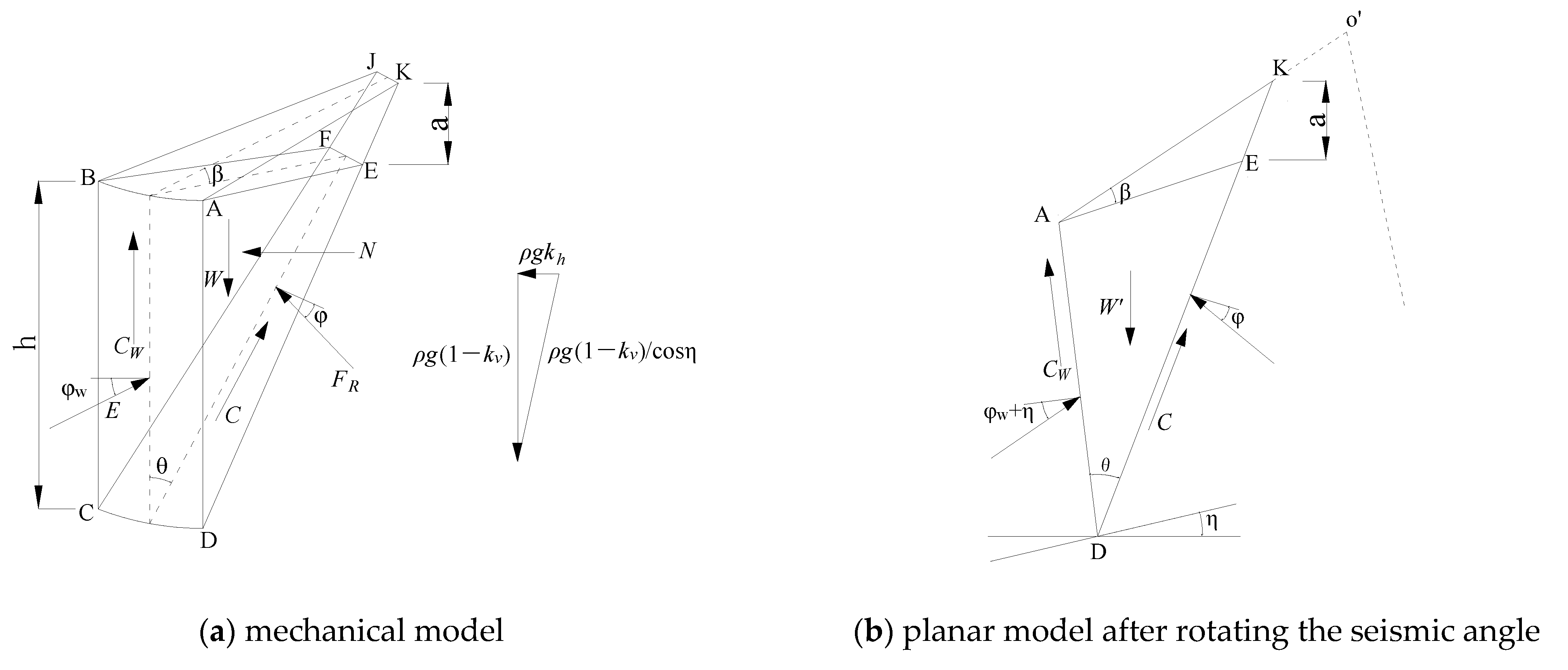
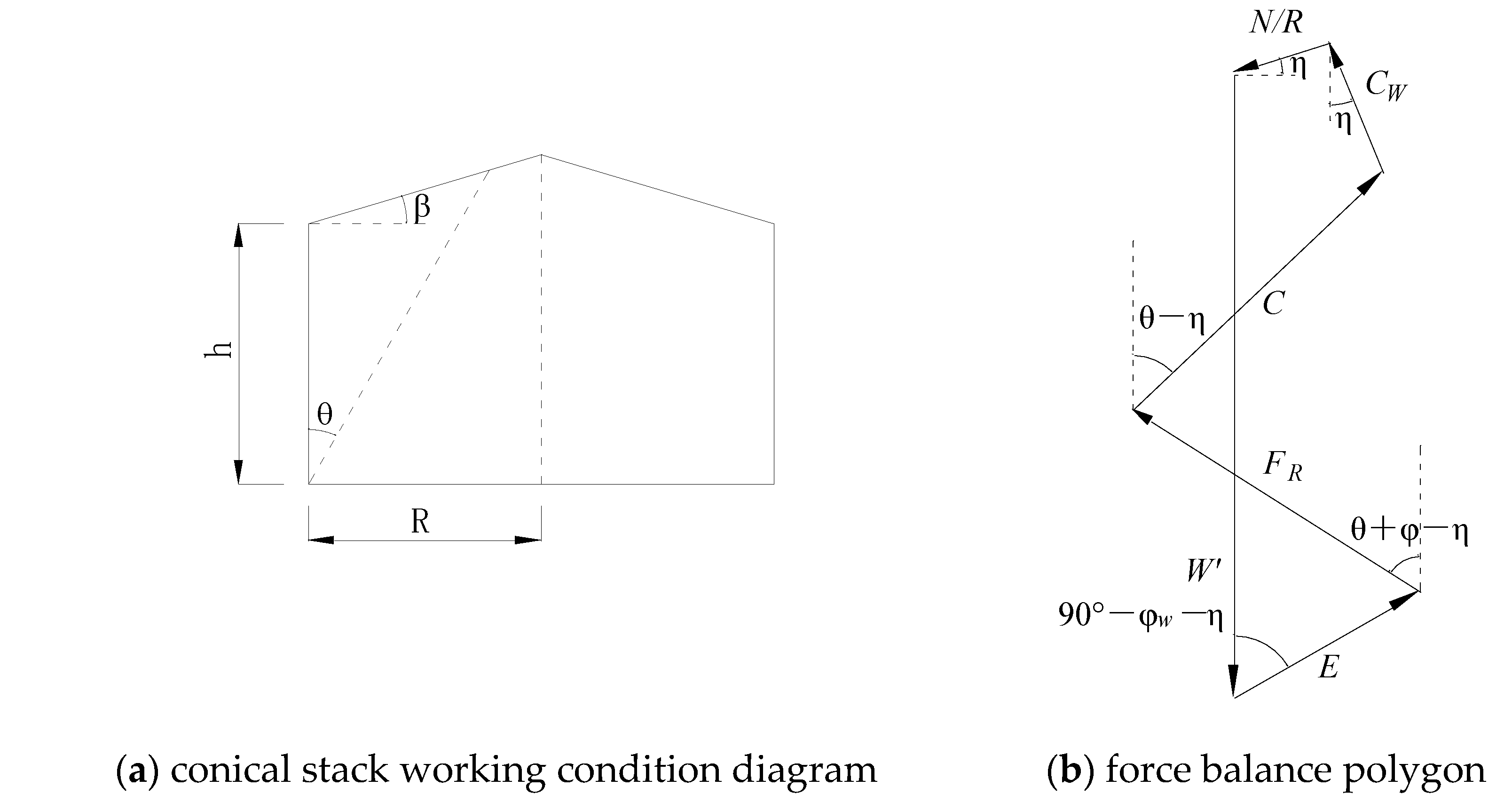
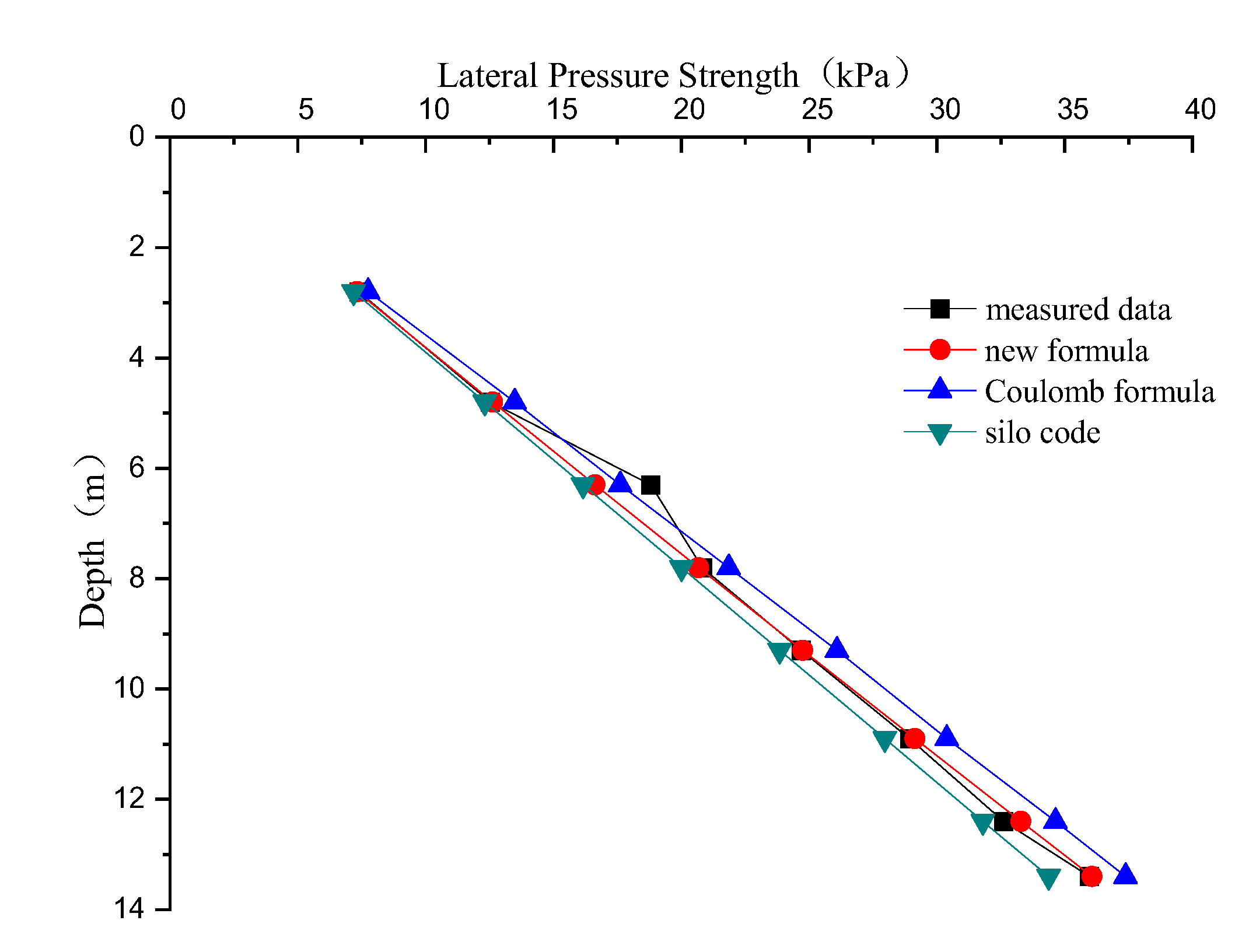
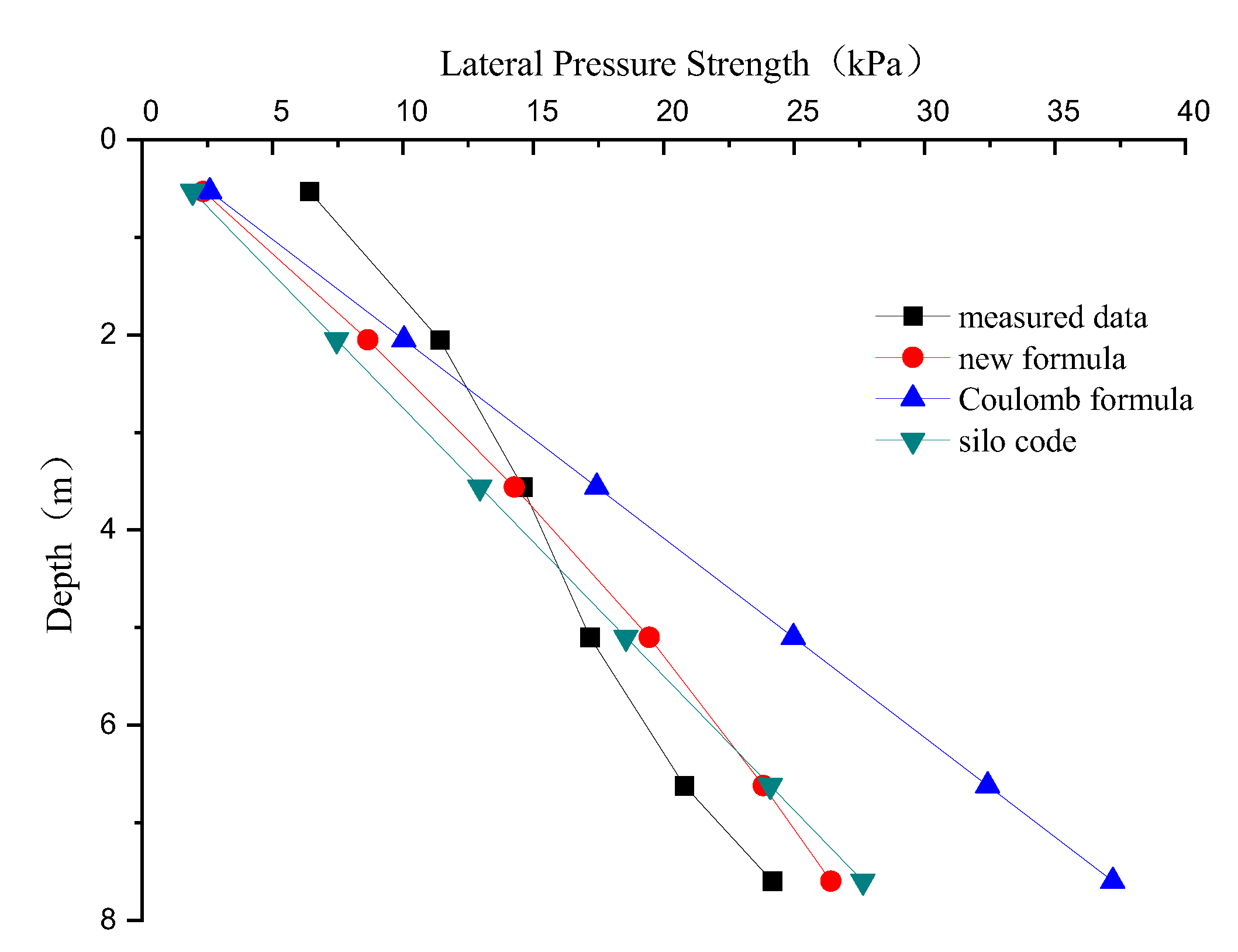
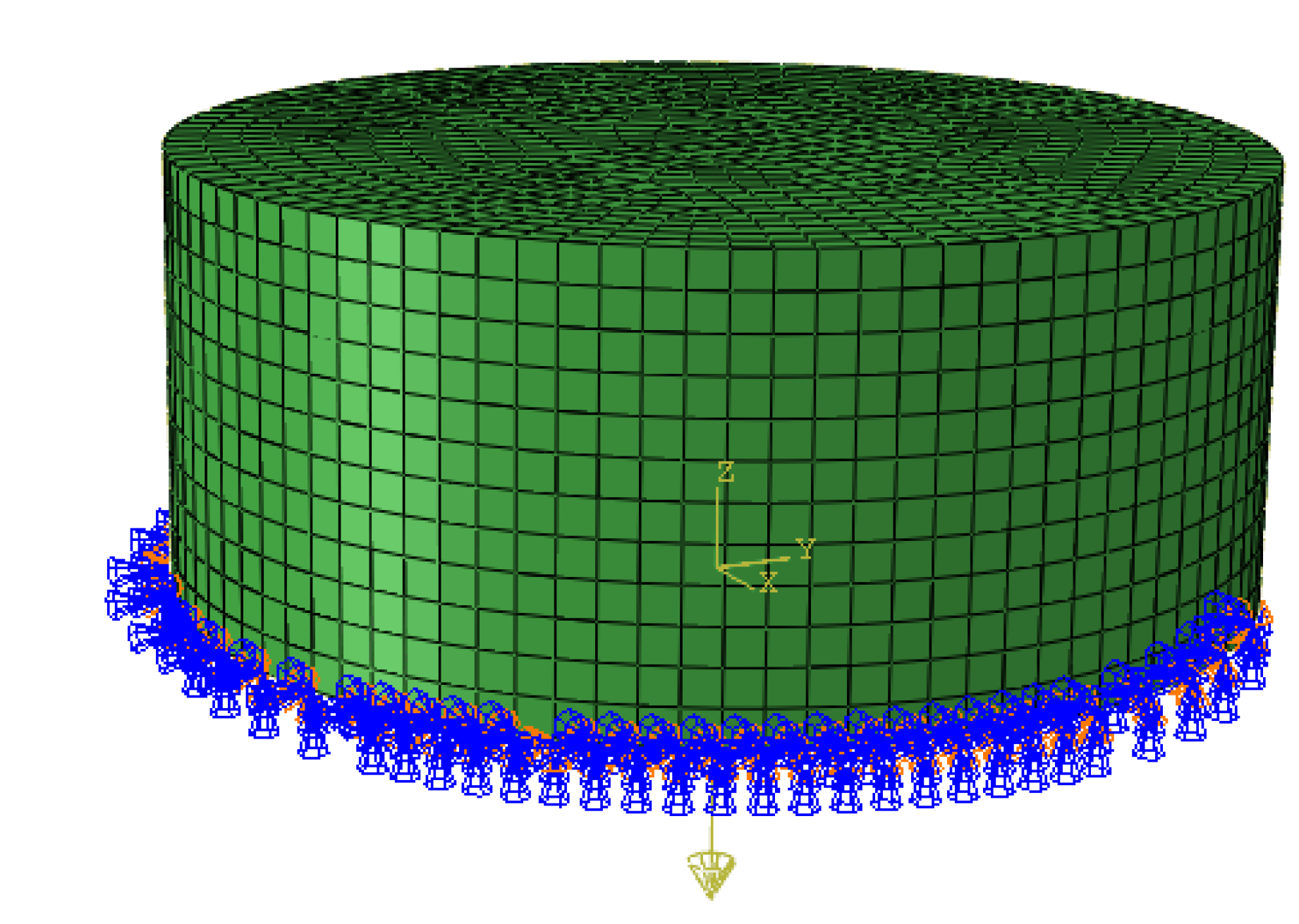

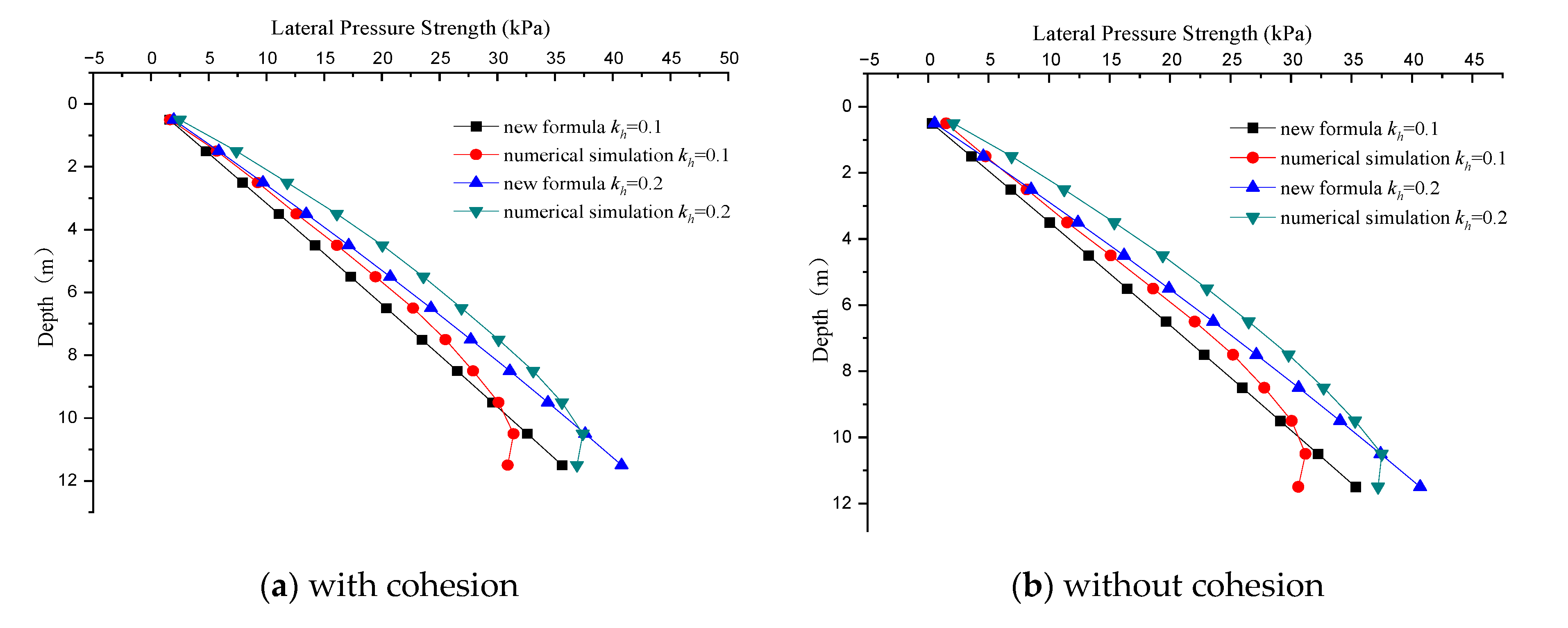
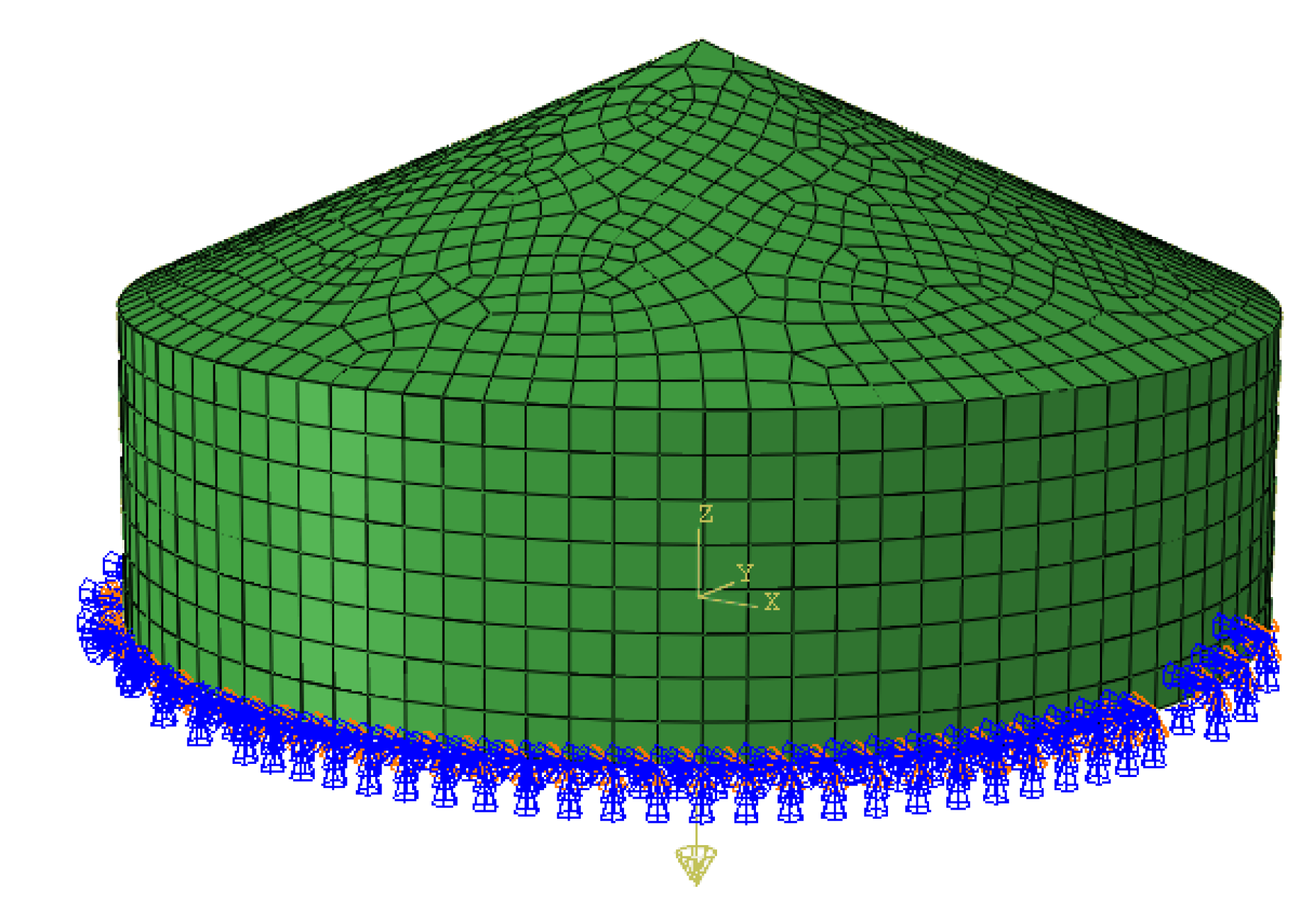

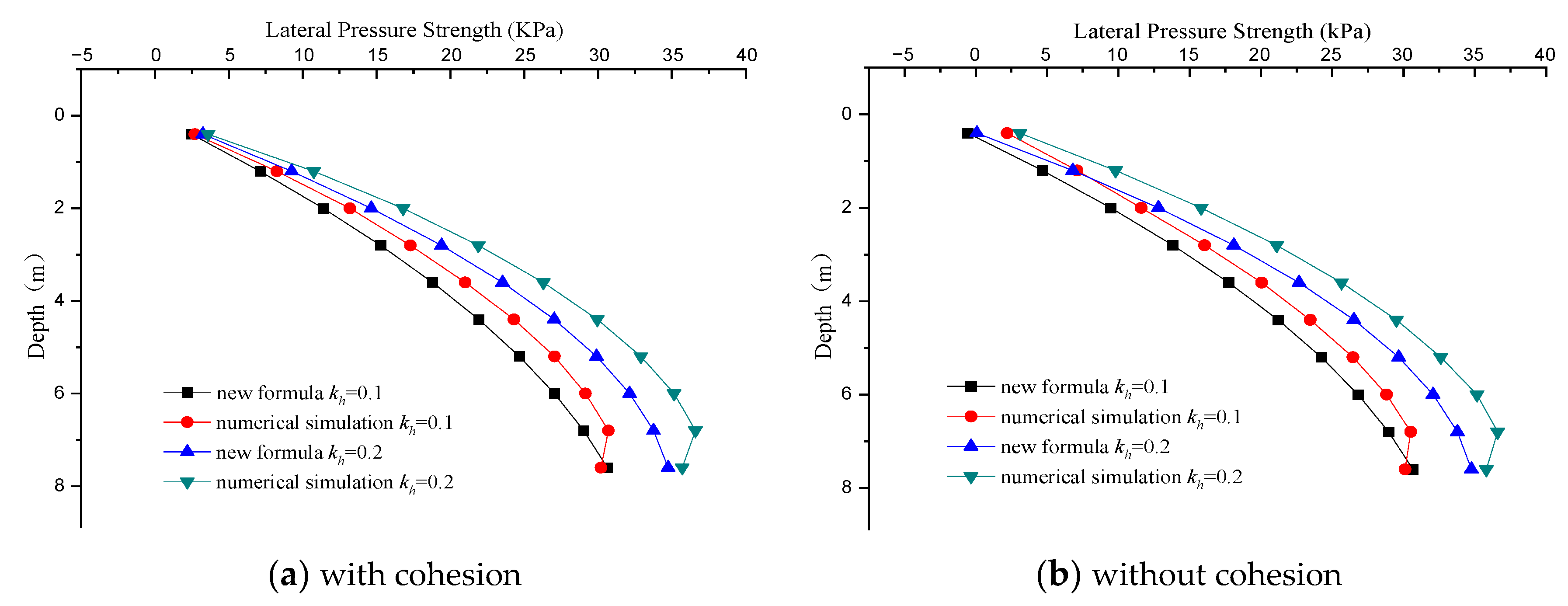
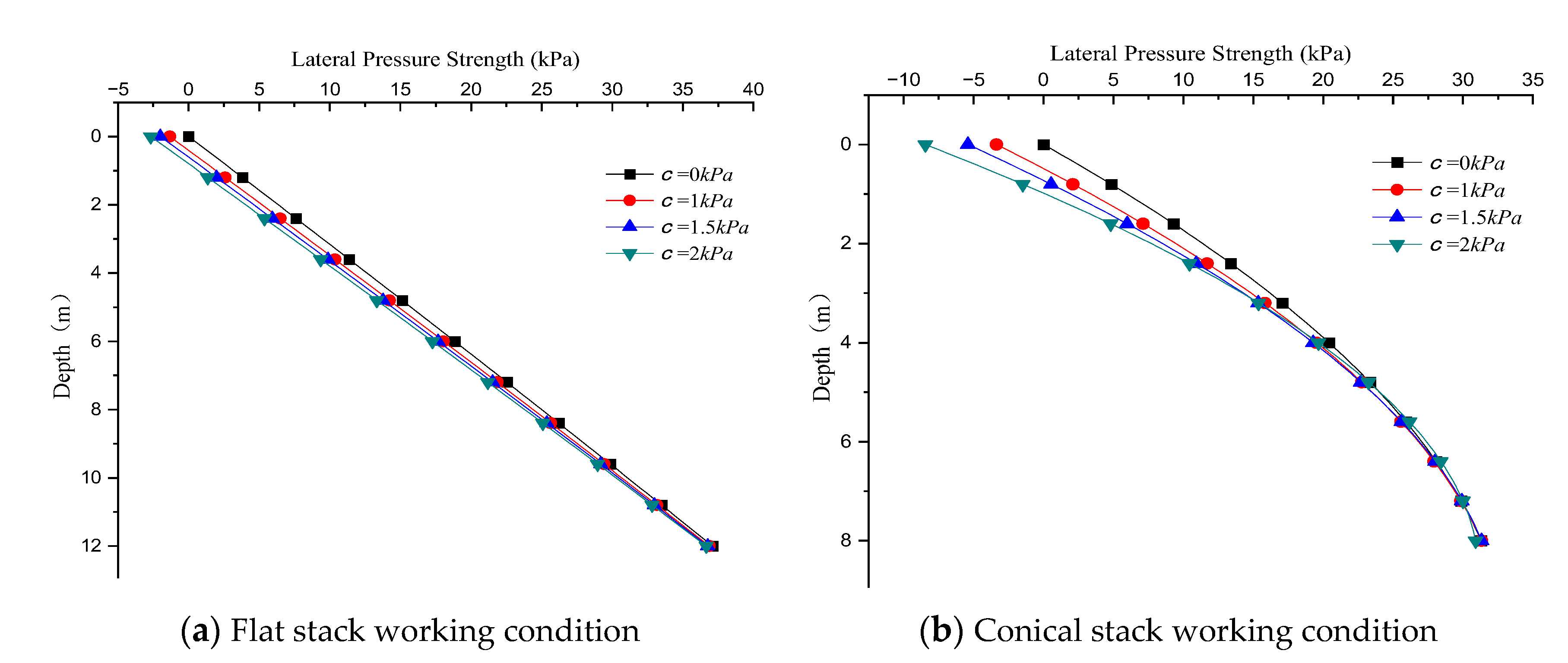
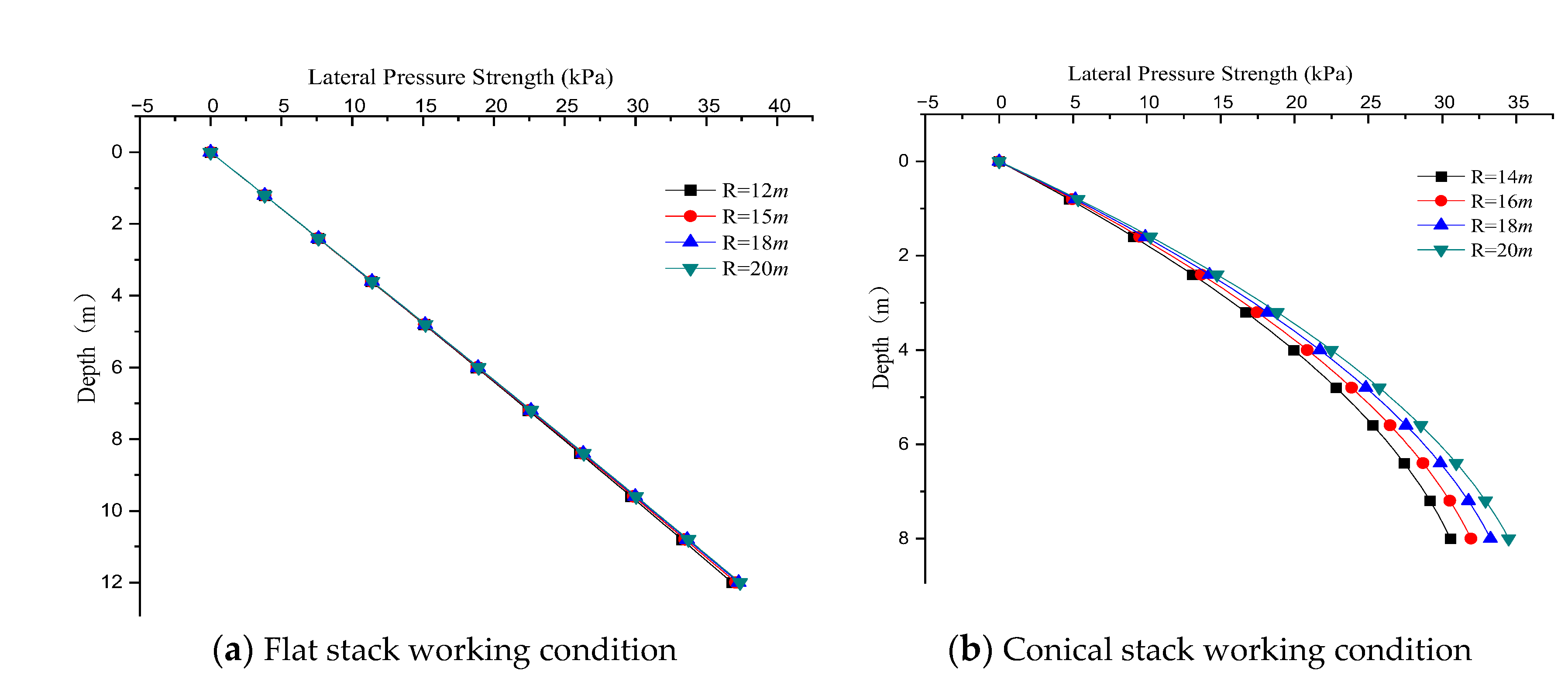

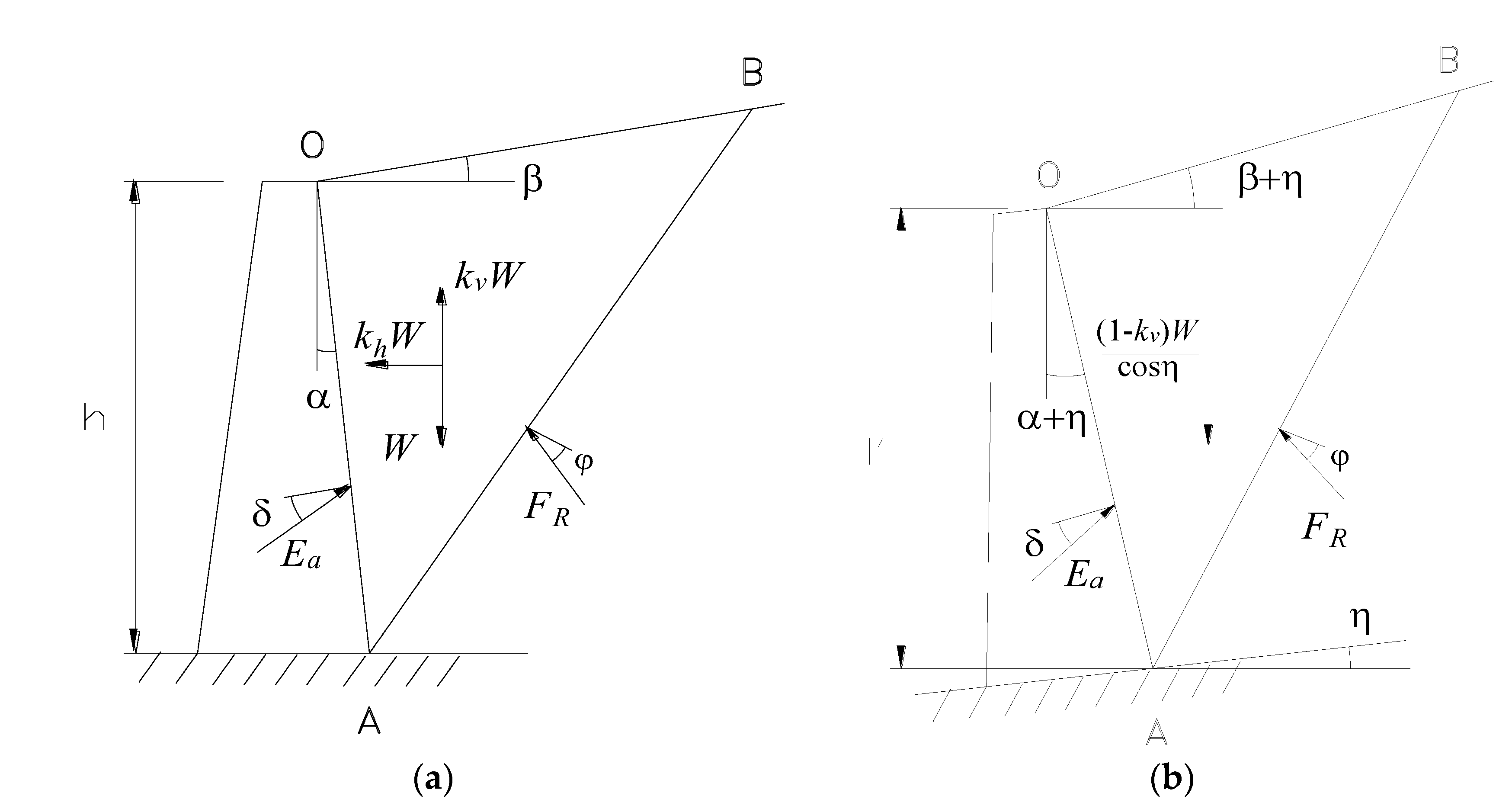
| Number | Depth (m) | Measured Data [31] (kPa) | New Formula (kPa) | Coulomb Formula (kPa) | Silo Code [27] (kPa) |
|---|---|---|---|---|---|
| 1 | 2.8 | 7.38 | 7.32 | 7.75 | 7.18 |
| 2 | 4.8 | 12.53 | 12.62 | 13.48 | 12.31 |
| 3 | 6.3 | 18.81 | 16.63 | 17.61 | 16.16 |
| 4 | 7.8 | 20.82 | 20.68 | 21.86 | 20.01 |
| 5 | 9.3 | 24.69 | 24.75 | 26.09 | 23.85 |
| 6 | 10.9 | 28.92 | 29.14 | 30.39 | 27.96 |
| 7 | 12.4 | 32.61 | 33.29 | 34.64 | 31.80 |
| 8 | 13.4 | 35.97 | 36.07 | 37.38 | 34.37 |
| Number | Depth (m) | Measured Data [31] (kPa) | New Formula (kPa) | Coulomb Formula (kPa) | Silo Code [27] (kPa) |
|---|---|---|---|---|---|
| 1 | 0.53 | 6.41 | 2.35 | 2.59 | 1.93 |
| 2 | 2.05 | 11.41 | 8.65 | 10.04 | 7.46 |
| 3 | 3.56 | 14.59 | 14.27 | 17.43 | 12.95 |
| 4 | 5.10 | 17.17 | 19.44 | 24.97 | 18.55 |
| 5 | 6.62 | 20.79 | 23.82 | 32.42 | 24.08 |
| 6 | 7.60 | 24.16 | 26.41 | 37.22 | 27.64 |
| Elastic Modulus (GPa) | μ | ρ (kg/m3) | φ (°) | φw (°) | Friction Coefficient |
|---|---|---|---|---|---|
| 30 | 0.2 | 2700 | 25 | 21.8 | 0.4 |
| Elastic Modulus (GPa) | μ | ρ (kg/m3) | c (kPa) in Flat Stack | c (kPa) in Conical Stack |
|---|---|---|---|---|
| 20 | 0.3 | 788 | 0 or 1 | 0 or 2 |
| R (m) | h (m) | kh | β (°) | |
|---|---|---|---|---|
| In flat stack working condition | 15 | 12 | 0.1 | / |
| In conical stack working condition | 15 | 8 | 0.1 | 25 |
Disclaimer/Publisher’s Note: The statements, opinions and data contained in all publications are solely those of the individual author(s) and contributor(s) and not of MDPI and/or the editor(s). MDPI and/or the editor(s) disclaim responsibility for any injury to people or property resulting from any ideas, methods, instructions or products referred to in the content. |
© 2023 by the authors. Licensee MDPI, Basel, Switzerland. This article is an open access article distributed under the terms and conditions of the Creative Commons Attribution (CC BY) license (https://creativecommons.org/licenses/by/4.0/).
Share and Cite
Zhang, G.; Zeng, R. Formula Derivation and Analysis of the Seismic Lateral Pressure of Squat Silos. Sustainability 2023, 15, 5098. https://doi.org/10.3390/su15065098
Zhang G, Zeng R. Formula Derivation and Analysis of the Seismic Lateral Pressure of Squat Silos. Sustainability. 2023; 15(6):5098. https://doi.org/10.3390/su15065098
Chicago/Turabian StyleZhang, Guoxiang, and Rong Zeng. 2023. "Formula Derivation and Analysis of the Seismic Lateral Pressure of Squat Silos" Sustainability 15, no. 6: 5098. https://doi.org/10.3390/su15065098
APA StyleZhang, G., & Zeng, R. (2023). Formula Derivation and Analysis of the Seismic Lateral Pressure of Squat Silos. Sustainability, 15(6), 5098. https://doi.org/10.3390/su15065098






